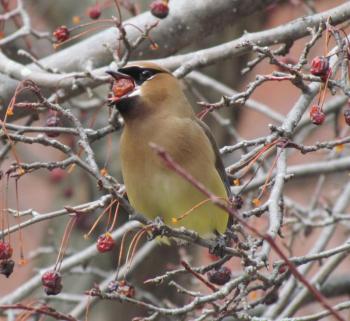Six Hungry Waxwings
We looked out our kitchen window this morning and saw six cedar waxwings. We hadn’t seen any around our neighborhood since last fall. These six were sitting in our crabapple tree, hungrily eyeing the few rather pitiful, shriveled up crabapples that remained. Over the last few days, American robins have also been appearing in the area. One was even giving a few snippets of song on a particularly warm day.
Both waxwings and robins are almost entirely dependent on fruit during the winter. For them, the late- winter/early-spring period must be one of the toughest to survive. Most berries and fruits would have been long ago eaten, and those that remained would be fermented and rotting. The types of berries or other fruits that show in abundance in late winter are almost certainly varieties that contain chemical compounds that make them unpalatable and difficult to digest.
The late- winter/early-spring period was also known as a difficult time for us humans before the modern age. Native Americans had to find food in between the last harvests of the winter mammals and before the arrival of returning migratory birds and fish. Our ancestors who came to these shores tried to store foods to have enough to make it through that difficult period, but there are many stories of desperation before spring brought back fish, birds, and other foods.
Birds, like people, that are more omnivorous, have more options for surviving periods of food scarcity. Unlike the fruit-eating waxwings and robins, the red-winged blackbirds that have been reported as new arrivals in many parts of southern Maine this week are more omnivorous. They often seem to find backyard bird-feeding stations and scarf down lots of whatever bird seed is offered. Their close relatives, the grackles and cowbirds, both of which are also usually early migrant arrivals, do the same.
The turkey vultures that birders have reported returning this week may take advantage of increased numbers of road-killed mammals that begin roaming during February thaws. We know that a local skunk, for example, has been active in our yard based on some strong, unpleasant smells the last two evenings.
Many people are surprised to learn that gulls begin migrating through Maine in February as they return to breeding grounds to our north. The opportunistic nature of gulls must certainly be an advantage at this time of the year. Migrant gulls probably are very clever about watching for places where other gulls are congregating as they travel so they can find food sources, whether at dumps, parks where people throw them bread scraps, following fishing boats, or begging from cars at fast food parking lots.
Some birds rely on fat reserves that they built up in late fall and early winter to make it through the slim pickings before spring arrives in earnest. We heard a killdeer flying over Augusta on a warm day last week. We couldn’t imagine that species could have found any food at all in that area. Hopefully it flew back closer to the coast where it might have had at least a chance of finding something to eat on a beach or mudflat. If not, fat reserves would have been its only hope.
The long supply chains of our modern interconnected world that can bring us strawberries from Florida and blueberries from Chile in the winter can make us forget the struggles of survival endured by birds and other animals at this time of year. Hopefully as we all become more aware of those struggles, we will also keep working to protect and restore habitat that provides food and shelter for them and to ensure we have policies and leaders who care about all aspects of our natural world.
Jeffrey V. Wells, Ph.D., is a Fellow of the Cornell Lab of Ornithology and Vice President of Boreal Conservation for National Audubon. Dr. Wells is one of the nation's leading bird experts and conservation biologists and author of “Birder’s Conservation Handbook”. His grandfather, the late John Chase, was a columnist for the Boothbay Register for many years. Allison Childs Wells, formerly of the Cornell Lab of Ornithology, is a senior director at the Natural Resources Council of Maine, a nonprofit membership organization working statewide to protect the nature of Maine. Both are widely published natural history writers and are the authors of the book, “Maine’s Favorite Birds” and “Birds of Aruba, Bonaire, and Curaçao: A Site and Field Guide” from Cornell Press.































